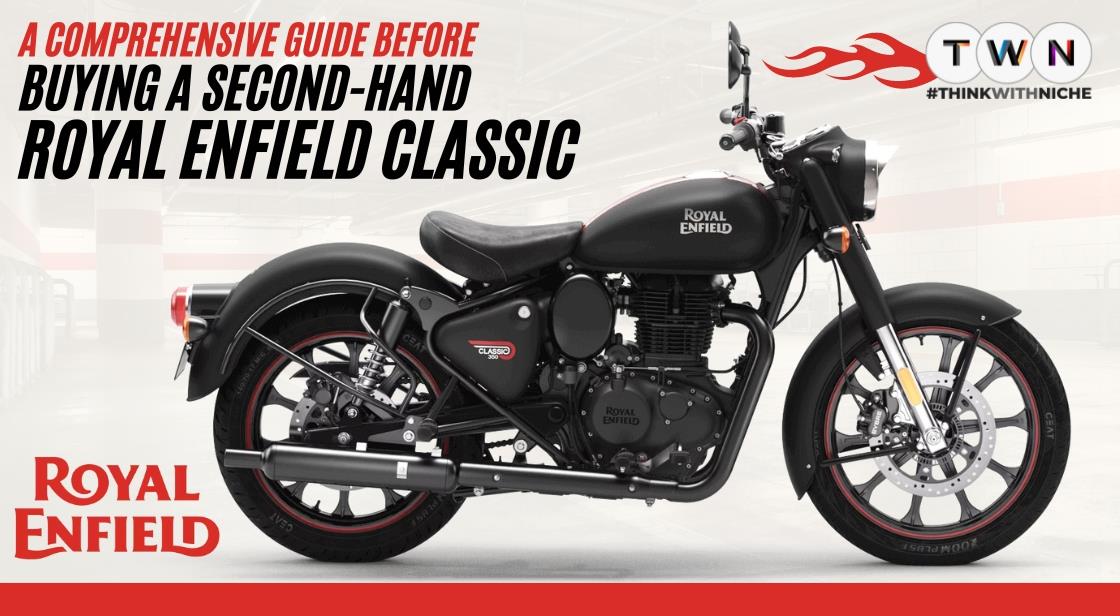A Comprehensive Guide Before Buying A Second-Hand Royal Enfield Classic

Blog Post
Are you considering buying a second-hand Royal Enfield Classic motorcycle? The Royal Enfield Classic is an iconic model known for its timeless design, retro appeal, and captivating riding experience.
However, purchasing a used motorcycle requires careful consideration and thorough research to ensure you make a wise investment.
In this comprehensive guide, we will walk you through the essential steps and key factors to consider before buying a second-hand Royal Enfield Classic.
From conducting in-depth research and budgeting to inspecting the bike's condition and ensuring a smooth ownership transfer, we will equip you with the knowledge and insights needed to make an informed decision.
Let's explore the essential elements of this buying journey, enabling you to find a well-maintained and reliable Royal Enfield Classic that brings joy and satisfaction to your riding adventures.
The Royal Enfield Classic is a popular motorcycle model manufactured by Royal Enfield, an iconic Indian motorcycle brand. The Royal Enfield Classic offers a distinctive blend of classic styling, nostalgia, and an enjoyable riding experience. Its timeless design, strong build quality, and the brand's legacy make it a sought-after choice for riders looking for a retro-inspired motorcycle with a unique character.
Are you planning to buy a second hand Royal Enfield Classic? Read this detailed guide buying it.
A Comprehensive Guide Before Buying a Second-Hand Royal Enfield Classic
1. Research:
When conducting thorough research about a specific Royal Enfield Classic model you are interested in, here are some key aspects to consider:
a) Specifications: Familiarize yourself with the specifications of the Royal Enfield Classic model, including the engine capacity, power output, torque, fuel efficiency, weight, and dimensions. Understanding these details will give you an idea of the bike's performance capabilities.
b) Features: Explore the features offered in the Royal Enfield Classic model you are interested in. This may include aspects such as the type of brakes, suspension system, transmission, lighting system, instrument cluster, and available variants. Determine which features are important to you and align with your preferences.
c) Common issues: Research common issues or known problems associated with the specific Royal Enfield Classic model. This can help you understand potential areas of concern and whether they have been addressed or resolved in newer versions or through aftermarket modifications. Online forums, user groups, and customer reviews can provide valuable insights in this regard.
d) Market value: Determine the market value of the Royal Enfield Classic model you are interested in. Consider factors such as the model year, mileage, condition, and location. Online classifieds, dealerships, and pricing guides can help you gauge the typical price range for used or new bikes of that model.
e) Expert and owner reviews: Seek out expert reviews from motorcycle publications or websites that have tested the Royal Enfield Classic model you are interested in. These reviews often provide comprehensive information about the bike's performance, handling, comfort, and overall ownership experience. Additionally, reading reviews and feedback from current or past owners can give you insights into real-world experiences and any specific issues they may have encountered.
f) Aftermarket modifications and customization: If you are interested in customizing or modifying your Royal Enfield Classic, research the availability of aftermarket parts, accessories, and customization options for that particular model. This will help you understand the possibilities for personalizing the bike according to your preferences.
g) Maintenance and service: Consider the maintenance requirements and availability of service centers for the Royal Enfield Classic model you are interested in. Look for authorized service centers or reputable mechanics who are experienced in working on Royal Enfield motorcycles. Understanding the maintenance schedule and costs associated with the bike will give you a clearer picture of its long-term ownership experience.
Conducting thorough research on the specifications, features, common issues, and market value of the Royal Enfield Classic model you are interested in, you'll be equipped with the necessary information to make an informed decision. This research will help you evaluate the bike's suitability for your needs and ensure that it aligns with your expectations in terms of performance, reliability, and ownership experience.
2. Budget:
Determine your budget for purchasing a used Royal Enfield Classic. Consider not only the purchase price but also additional costs such as second hand bike insurance online, registration, and any potential repairs or modifications.
3. Source:
Find a reliable and trustworthy source to purchase the motorcycle. Consider authorized Royal Enfield dealers, reputable used motorcycle dealerships, or trusted online platforms with a good track record for selling second-hand motorcycles.
4. Physical inspection:
When conducting a physical inspection of a second-hand Royal Enfield Classic, here are some key areas to focus on:
a) Overall condition: Start by assessing the overall condition of the motorcycle. Look for any signs of damage, rust, or major scratches on the bodywork. Check for any visible dents or misalignments that may indicate previous accidents or mishandling.
b) Frame and chassis: Examine the frame and chassis for any signs of structural damage or cracks. Look for any welding marks or repairs that may indicate previous damage. Ensure that the frame is straight and aligned properly.
c) Engine: Inspect the engine for any oil leaks, coolant leaks, or unusual noises. Check the engine's general cleanliness and look for signs of regular maintenance. Start the engine and observe its idle behavior and response to throttle inputs.
d) Suspension and brakes: Check the suspension components for any leaks, damage, or excessive play. Test the suspension by compressing and releasing it to see if it responds smoothly. Assess the condition of the brake discs, pads, and calipers. Test the brakes to ensure they provide adequate stopping power.
e) Tires: Inspect the tires for signs of wear, cracks, or bulges. Check the tire tread depth to determine if they need replacement soon. Uneven wear patterns may indicate issues with the alignment or suspension.
f) Electrical system: Test the functioning of all electrical components, such as the headlights, indicators, taillights, horn, and instrument cluster. Check if all switches and controls are working properly. Ensure that the battery is in good condition.
g) Documentation and ownership: Verify the ownership documents, including the registration certificate (RC), Royal Enfield insurance papers, and pollution under control (PUC) certificate. Ensure that the seller has clear ownership and there are no outstanding loans or legal issues associated with the motorcycle.
h) Test ride: If possible and with the seller's permission, take the Royal Enfield Classic for a test ride. Pay attention to the bike's handling, clutch operation, gearbox smoothness, and overall ride comfort. Observe if there are any abnormal vibrations or noises during the ride.
i) Service and maintenance history: Request the service records to check if the motorcycle has been regularly serviced and maintained. Look for any past repairs, part replacements, or modifications. A well-maintained bike with a documented service history is generally more reliable.
It is advisable to conduct the inspection in daylight and with a thorough checklist to ensure that you don't miss any important aspects. If you are not confident in assessing the bike's condition yourself, consider bringing along an experienced mechanic or seeking a professional inspection service to get a comprehensive evaluation.
5. Ownership Transfer:
Ensure that the ownership transfer process is properly executed. Verify that the seller provides all the necessary documents for transferring ownership to your name, including a valid NOC (No Objection Certificate) if the motorcycle is from a different state.
6. Legal and Financial Check:
Conduct a legal and financial check on the motorcycle. Ensure that there are no pending loans or liabilities associated with the bike. It's recommended to perform a background check through a reputable agency to avoid any legal or financial complications.
Conclusion:
Remember to exercise due diligence and take your time when buying a second-hand Royal Enfield Classic. By following this comprehensive guide, you can increase the chances of finding a well-maintained and reliable motorcycle that meets your requirements and provides an enjoyable riding experience.
You May Like
EDITOR’S CHOICE












